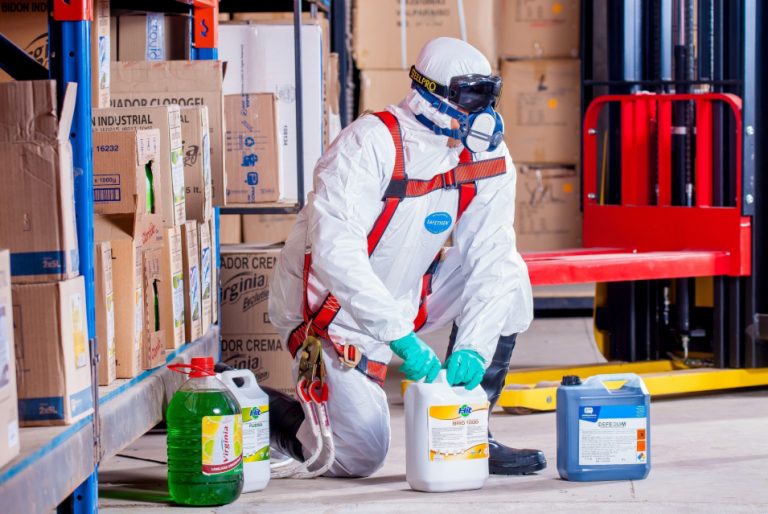When chemicals are used, stored, or generated in the workplace, there are unique hazards. Some have properties that make them an immediate safety concern, like explosive, flammable, and corrosive chemicals. Others cause adverse health effects on our body and even long-term illness.
The Canadian Centre for Occupational Health and Safety notes that over the last several decades, research has not only offered insight into why certain illnesses are common in certain occupations, but also led to advances in preventing occupational disease through the implementation of control measures, such as using alternative chemicals that are less harmful.
Identifying hazards and assessing risk
Each workplace is unique. Employers have a responsibility to recognize the hazards by identifying all chemicals that are used, stored, handled, and generated in their workplace. They must also assess the risk of exposure to chemicals for their specific workplace, considering both the likelihood and severity of the exposure. These risks will be dependent on the chemicals that are present, the type and duration of tasks being performed, the work environment, and other workplace-specific factors. Once risks are assessed, employers must implement appropriate control measures, following the hierarchy of controls. In some situations, additional information such as occupational hygiene monitoring is needed to assess the hazard.
Understanding routes of exposure is another key part of the risk assessment. Inhalation is the most common, followed by contact with skin or less frequently, eyes. Accidental ingestion can happen if food, hands, or cigarettes are contaminated, so workers should not drink, eat, or smoke in areas where they may be exposed to chemicals. Injection is a less common method of exposure, occurring when a sharp object punctures the skin and injects a chemical directly into the bloodstream. Regardless of how the chemical gets into the body, once inside it is distributed by the bloodstream. In this way, the chemical can harm organs which are far away from the original point of entry, as well as where it had entered the body.
It may be many years between the time of exposure to the hazardous chemical and the development of a disease. This is known as the latency period. Many occupational diseases have longer latency periods – they tend to be detected after prolonged exposure over time, making it challenging for researchers to track and study. For example, mesothelioma (from asbestos exposure) rarely appears less than 10 years from the time of the first exposure and it may only appear after 40 years. It is critical that employers provide education and training about the potential hazards of the products and how to work with them safely.
There are several places to obtain information on the hazards and how to work safely with chemicals, including the supplier and workplace labels, and safety data sheets (SDSs). Section 2 of the SDS includes an overview of the physical and health hazards and any special warnings about the physical and health hazards of the chemical. Always consult the manufacturer’s instructions for the safe use, handling, and storage of the substance. You can also source credible information from health and safety organizations.
General health and safety when working with chemicals
After the hazards and risks of chemicals have been identified and assessed, appropriate control measures need to be put in place to protect workers. It is important to control the hazards by considering the most effective measures first, also known as the hierarchy of controls.
Elimination and substitution are the first and most effective control measures in the hierarchy, which involve removing the hazardous chemical from the workplace and/or replacing it with a less hazardous one. If elimination or substitution is not feasible or if there is remaining risk, the next most effective measure is engineering controls. These include design updates or modifications to plants, equipment, ventilation systems, and processes that reduce the source of exposure. Administrative controls, the third-most effective measure, alter the way the work is done, including timing or work, policies, work practices, and other rules. Workers also need to be trained on these workplace-specific procedures, including first aid measures in case of exposure and how to respond to spills. The last control measure to consider when other controls are unable to adequately protect workers is personal protective equipment (PPE).
Workplace hazard control should be overseen and implemented by qualified individuals, and in consultation with health and safety committees or representatives, supervisors, and workers. It is also important to always follow the requirements of the applicable occupational health and safety legislation, fire codes, building codes, environmental regulations, transportation of dangerous goods (TDG) regulations, and industry standards. When developing procedures for proper storage and disposal of a chemical, follow the SDS recommendations, along with any regulatory requirements, standards, and codes for your jurisdiction. Ensure all containers are clearly labelled to avoid misuse or incidents.
The psychological safety of a workplace has the potential to be a major hazard. Stress is often a factor when workers take shortcuts with handling chemicals, so it’s crucial that employers create an environment where workers are encouraged to come forward immediately to report hazards such as exhaustion, a lack of proper PPE, missing labels, or improper storage. Workers need to feel safe to voice their concerns and to request additional training or other solutions to protect their health and safety, without fear of reprisal or humiliation.
Finally, when working with a chemical, make sure the necessary controls are followed to limit exposure, as outlined in your workplace’s procedure for the specific chemical and task. This will include requirements for ventilation, the kind of PPE that needs to be worn, proper storage and disposal procedures, and other measures. If you have not received training on how to work safely with the chemical, or have other concerns, report this immediately to your supervisor.
Source: CCOHS








